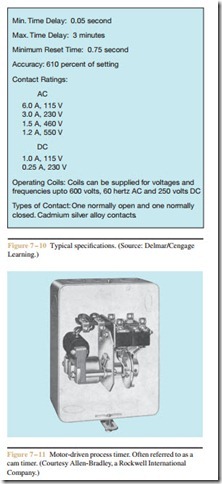Motor-Driven Timers
When a process has a definite on and off operation, or a sequence of successive operations, a motor-driven timer is generally used (Figure 7– 10 and Figure 7– 11). A typical application of a motor-driven timer is to con- trol laundry washers where the loaded motor is run for a given period in one direction, reversed, and then run in the opposite direction.
Generally, this type of timer consists of a small, synchronous motor driving a cam-dial assembly on a common shaft. A motor-driven timer successively closes and opens switch contacts, which are wired in circuits to energize control relays or contactors to achieve desired operations.
Related posts:
POWER ELECTRONICS, RECTIFIERS, AND PULSE-WIDTH MODULATION INVERTERS:PULSE CIRCUITS
Multicore Cables and Cabletray:Fire Performance Cables
Feedback Control Theory:Linear System
Theory of Unmarked Lead Test
MOTOR CONTROL
Programmable Controllers An engineer’s guide - Appendix Number systems
Low Core Flux Test (EL-CID)
Development of Control Circuits part1
Troubleshooting variable speed drives:Commissioning VSDs
Measurement:The Equivalent Level (LEQ) in Noise Measurements
VARIABLE-SPEED DRIVES:CABLE DETAILS
DATA TRANSMISSION INTERFACES:DATA TRANSMISSION BASICS
Output Devices part3
ZIG-ZAG AIRGAP LEAKAGE INDUCTANCES
